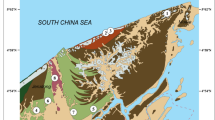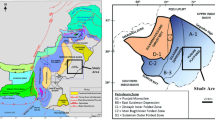Abstract
Geological characteristics and shale-gas exploration potential have been intensely evaluated, using newly collected core (137 m long) and a full suite of wireline logs from the Lower Smackover Formation (Brown Dense), northern Louisiana. The study results have revealed that the Brown Dense comprises three progradational parasequence sets, each set of which contains 15–25, small-scale parasequences that are expressed as highly serrated-log motif. Individual parasequences reflect distinctive lithologic variations of basal, laminated mudstones (offshore transitional deposit) and upper, ooid-peloid packstones (high-energy shallow marine deposit). The mudstones are mainly composed of calcite, quartz, dolomite and pyrite with moderate amounts of diagenetic clays, whereas in the pack-stones the predominant calcite content is readily apparent with small amounts of other minerals. Matrix pore types comprise dominant interparticle and intraparticle pores in the mudstones, but mainly interparticle pores in the packstones. The pyrite occurrence is proportionally related to the organic-matter content that shows high-low amount couplets within parasequence-scale, lithologic variations. Porosity and permeability show a positive correlation with effective porosity ranging from 1 to 6% and permeability varying from less than 0.1 µd to larger than 1mD. As compared with stratigraphic packages, three types of the porosity and permeability trend can be recognized, including positive, negative and random relationships. These features are likely influenced by the degree of pressure solution (i.e., stylolites). Rock-Eval/TOC analysis has shown that organic matter consists mainly of type-II oil-prone kerogen with TOC ranging from 0.55 wt% to 1.73 wt%. The transformation ratio of organic matter is estimated up to 80% that is broadly equivalent to the earliest gas window, supported also by Tmax values, showing late oil to wet-gas windows. Mechanical rock properties measured from static and dynamic methods have confirmed that rock brittleness of the cored well is considered to be good to excellent. In this study and unpublished proprietary data, we have found that mineral framework and organic-matter layering play an important role in controlling mechanical properties. The study results have tentatively concluded that the newly emerging Brown Dense shale has a high exploration potential, if completion and development strategies will become optimized.
Similar content being viewed by others
References
Barree, R.D., Miskimins, J.L., and Gilbert, J.V., 2014, Diagnostic fracture injection tests: common mistakes, misfires, and misdiagnoses. Society of Petroleum Engineers, Western North American and Rocky Mountain Joint Regional Meeting, Denver, Apr. 16–18, SPE-169539, 20 p. https://doi.org/10.2118/169539-PA
Bäuerle, G., Bornemann, O., Mauthe, F., and Michalzik, D., 2000, Origin of stylolites in Upper Permian Zechstein Anhydrite (Gorleben Salt Dome, Germany). Journal of Sedimentary Research, 70, 726–737.
Bird, D.E., Burke, K., Hall, S.A., and Casey, J.F., 2005, Gulf of Mexico tectonic history: hotspot tracks, crustal boundaries, and early salt distribution. Bulletin of American Association of Petroleum Geologists, 89, 311–328.
Briggs, D.E.G., Bottrell, S.H., and Raiswell, R., 1991, Pyritization of soft-bodied fossils: Beecher’s Trilobite Bed, Upper Ordovician, New York State. Geology, 9, 1221–1224.
Budd, D.A. and Loucks, R.G., 1981, Smackover and Lower Buckner formations, South Texas: depositional systems on a Jurassic carbonate ramp. Report No. 112, University of Texas at Austin, Bureau of Economic Geology, Report of Investigations, Austin, 38 p.
Cipolla, C., Weng, X., Mack, M., Ganguly, U., Gu, H., Kresse, O., and Cohen, C., 2011, Integrating microseismic mapping and complex fracture modeling to characterize fracture complexity. Society of Petroleum Engineers, Hydraulic Fracturing Technology Conference, Woodlands, Jan. 24–26, SPE-140185, 22 p. https://doi.org/10.2118/140185-MS
Clarkson, C.R. and Pedersen, P.K., 2011, Production analysis of Western Canadian unconventional light oil plays. Society of Petroleum Engineers, Canadian Unconventional Resources Conference, Calgary, Nov. 15–17, SPE-149005, 23 p. https://doi.org/10.2118/149005-MS
Clarkson, C.R., Wood, J.M., Burgis, S.E., Aquino, S.D., and Freeman, M., 2012, Nanopore-structure analysis and permeability predictions for a tight gas siltstone reservoir by use of low-pressure adsorption and mercury-intrusion techniques. SPE Reservoir Evaluation and Engineering, 15, 648–661.
Claypool, G.E. and Mancini, E.A., 1989, Geochemical relationships of petroleum in Mesozoic reservoirs to carbonate source rocks of Jurassic Smackover Formation, southwestern Alabama. The American Association of Petroleum Geologists Bulletin, 73, 904–924.
Ewing, T.E., 1991, Structural framework. In: Salvador, A. (ed.), The Gulf of Mexico Basin. Geological Society of America, Volume J, p. 31–52. https://doi.org/10.1130/DNAG-GNA-J.31
Harry, D.L. and Londono, J., 2004, Structure and evolution of the central Gulf of Mexico continental margin and coastal plain, southeast United States. Geological Society of America Bulletin, 116, 188–199.
Heydari, E., 2003, Meteoric versus burial control on porosity evolution of the Smackover Formation. The American Association of Petroleum Geologists Bulletin, 87, 1779–1797.
Heydari, E. and Baria, L.R., 2005, A conceptual model for the sequence stratigraphy of the Smackover Formation in north-central U.S. Gulf Coast. Gulf Coast Association of Geological Societies Transactions, 55, 321–340.
Heydari, E. and Moore, C.H., 1994, Paleoceanographic and paleoclimatic controls on ooid mineralogy of Smackover Formation, Mississippi Salt Basin: implications for Late Jurassic seawater composition. Journal of Sedimentary Research, 64, 101–114. https://doi.org/10.1306/D4267D25-2B26-11D7-8648000102C1865D
Heydari, E., Wade, W.J., and Anderson, L.C., 1997, Depositional environments, organic carbon accumulation, and solar-forcing cyclicity in Smackover Formation lime mudstones, northern Gulf Coast. The American Association of Petroleum Geologists Bulletin, 81, 760–774. https://doi.org/10.1306/522B4839-1727-11D7-8645000102C1865D
Jarvie, D.M., 2012, Shale resource systems for oil and gas: Part 1—Shale-gas resource systems. In: Breyer, J.A. (ed.), Shale Reservoirs-Giant Resources for the 21st Century. American Association of Petroleum Geologists Memoir, 97, p. 69–87. https://doi.org/10.1306/13321446M973489
Jarvie, D.M., Hill, R.J., Ruble, T.E., and Pollastro, R.M., 2007, Unconventional shale-gas systems: the Mississippi Barnett Shale of North-Central Texas as one model for thermogenic shale-gas assessment. The American Association of Petroleum Geologists Bulletin, 91, 475–499.
Jarvie, D.M. and Lundell, L.L., 2001, Kerogen type and thermal transformation of organic matter in the Miocene Monterey Formation. In: Isaacs, C.M. and Rullkotter, J. (eds.), The Monterey Formation: from Rocks to Molecules. Columbia University Press, New York, p. 268–295.
Kuppe, F., Haysom, S., and Nevokshonoff, G., 2012, Liquids rich unconventional Montney: the geology and the forecast. Society of Petroleum Engineers, Canadian Unconventional Resources Conference, Calgary, Oct. 30–Nov. 1, SPE-162824, 28 p. https://doi.org/10.2118/162824-MS
Loucks, R.G., Reed, R.M., Ruppel, S.C., and Hammes, U., 2012, Spectrum of pore types and networks in mudrocks and a descriptive classification for matrix-related mudrock pores. The American Association of Petroleum Geologists Bulletin, 96, 1071–1098.
Loucks, R.G., Reed, R.M., Ruppel, S.C., and Jarvie, D.M., 2009, Morphology, genesis, and distribution of nanometer-scale pores in siliceous mudstones of the Mississippian Barnett Shale. Journal of Sedimentary Research, 79, 848–861.
MacEachern, J.A., Bann, K.L., Bhattacharya, J.P., and Howell, C.D., 2005, Ichnology of deltas: organism responses to the dynamic interplay of rivers, waves, storms, and tides. In: Bhattacharya, J.P. and Giosan, L. (eds.), River Deltas: Concepts, Models and Examples. Society of Economic Paleontologists and Mineralogists, Special Publication, 83, p. 49–85. https://doi.org/10.2110/pec.05.83.0049
Mancini, E.A., Parcell, W.C., Ahr, W.M., Ramirez, V.O., Llinás, J.C., and Cameron, M., 2008, Upper Jurassic updip stratigraphic trap and associated Smackover microbial and nearshore carbonate facies, eastern Gulf coastal plain. The American Association of Petroleum Geologists Bulletin, 92, 417–442.
Mancini, E.A., Tew, B.H., and Mink, R.M., 1990, Jurassic sequence stratigraphy in the Mississippi Interior Salt Basin of Alabama. Gulf Coast Association of Geological Societies Transactions, 40, 521–529.
Masson, A.G., and Rust, B.R., 1983, Lacustrine stromatolites and algal laminites in a Pennsylvanian coal-bearing succession near Sydney, Nova Scotia, Canada. Canadian Journal of Earth Sciences, 20, 1111–1118.
McCarthy, K., Rojas, K., Niemann, M., Palmowski, D., Peters, K., and Stankiewicz, A., 2011, Basic petroleum geochemistry for source rock evaluation. Oilfield Review, 23, 32–43.
Meyer, M.J., Donovan, A.D., and Pope, M.C., 2021, Depositional environment and source rock quality of the Woodbine and Eagle Ford Groups, southern East Texas (Brazos) Basin: an integrated geochemical, sequence stratigraphic, and petrographic approach. The American Association of Petroleum Geologists Bulletin, 105, 809–843.
Newsham, K.E. and Rushing, J.A., 2001, An integrated work-flow process to characterize unconventional gas resources: Part I—Geological assessment and petrophysical evaluation. Society of Petroleum Engineers, Annual Technical Conference and Exhibition, New Orleans, Sep. 30–Oct. 3, SPE 71351, 13 p. https://doi.org/10.2118/71351-MS
Passey, Q.R., Bohacs, K.M., Esch, W.L., Klimentidis, R., and Sinha, S., 2010, From oil-prone source rock to gas-producing shale reservoir-geologic and petrophysical characterization of unconventional shale gas reservoirs. Society of Petroleum Engineers, International Oil and Gas Conference and Exhibition, Beijing, Jun. 8–10, SPE-131350, 29 p. https://doi.org/10.2118/131350-MS
Pindell, J.L., 1985, Alleghenian reconstructions and subsequent evolution of the Gulf of Mexico, Bahamas, and proto-Caribbean. Tectonics, 4, 1–39.
Rickman, R., Mullen, M., Petre, E., Grieser, B., and Kundert, D., 2008, A practical use of shale petrophysics for stimulation design optimization: all shale plays are not clones of the Barnett Shale. Society of Petroleum Engineers, Annual Technical Conference and Exhibition, Denver, Sep. 21–24, SPE-115258, 11 p. https://doi.org/10.2118/115258-MS
Salvador, A., 1987, Late Triassic-Jurassic paleogeography and origin of Gulf of Mexico basin. The American Association of Petroleum Geologists Bulletin, 71, 419–451.
Sassen, R. and Moore, C.H., 1988, Framework of hydrocarbon generation and destruction in Eastern Smackover Trend. The American Association of Petroleum Geologists Bulletin, 72, 649–663.
Sawyer, D.S., Buffler, R.T., and Pilger, R.H.Jr., 1991, The crust under the Gulf of Mexico basin. In: Salvador, A. (ed.), The Gulf of Mexico Basin. Geological Society of America, Volume J, p. 53–72. https://doi.org/10.1130/DNAG-GNA-J.53
Schieber, J. and Baird, G., 2001, On the origin and significance of pyrite spheres in Devonian black shale of North America. Journal of Sedimentary Research, 71, 155–166.
Slatt, R.M. and Rodriguez, N.D., 2012, Comparative sequence stratigraphy and organic geochemistry of gas shales: commonality or coincidence? Journal of Natural Gas Science and Engineering, 8, 68–84.
Toussaint, R., Aharonov, E., Koehn, D., Gratier, J.P., Ebner, M., Baud, P., Rolland, A., and Renard, F., 2018, Stylolites: a review. Structural Geology, 114, 163–195.
Valori, A., Ali, F., Taherian, R., Badri, M., Abdallah, W., and Cheshire, S.G., 2016, Shale gas production profiling by NMR. Society of Petroleum Engineers, International Petroleum Exhibition and Conference, Abu Dhabi, Nov. 7–10, SPE-183280, 15 p. https://doi.org/10.2118/183280-MS
Van Wagoner, J.C., Mitchum, R.M., Campion, K.M., and Rahmanian, V.D., 1990, Siliciclastic sequence stratigraphy in well logs, core, and outcrops: concepts for high resolution correlation of time and facies. American Association of Petroleum Geologists, Methods in Exploration, 7, 55 p. https://doi.org/10.1306/Mth7510
Warpinski, N.R., Peterson, R.E., Branagan, P.T., Engler, B.P., and Wolhart, S.L., 1998, In situ stress and moduli: comparison of values derived from multiple techniques. Society of Petroleum Engineers, Annual Technical Conference and Exhibition, New Orleans, Sep. 27–30, SPE-49190, 15 p. https://doi.org/10.2118/49190-MS
Yang, B.C., 2018, Geological characteristics and reservoir properties in the unconventional Montney Formation, southwestern Alberta, Canada. Geosciences Journal, 22, 313–325.
Zeid, A. and Lee, J., 2017, Unconventional shale gas development in Saudi and Algeria—assessment using USA key success factors framework. Offshore Technology Conference, Houston, May 1–4, OTC-27908, 31 p. https://doi.org/10.4043/27908-MS
Acknowledgments
This work is a small part of the regional shale-gas exploration project, conducted by Ankorenergy and Korea National Oil Corporation across the Louisiana Salt Basin. Ankorenergy is thanked for permission to publish this research. We would like to thank two anonymous reviewers for their constructive criticisms that served to improve the manuscript substantially, and the editorial comments of Dr. H.S. Lim. We also thank many colleagues, Shin, S.M., Lee, D.G., Lee, Y.R., Kim, S.H. and Choi, J.W., who have supported this project over the many years.
Author information
Authors and Affiliations
Corresponding author
Additional information
Publisher’s Note
Springer Nature remains neutral with regard to jurisdictional claims in published maps and institutional affiliations.
Rights and permissions
About this article
Cite this article
Yang, B., Lee, Y. & Chang, T.S. Introduction to unconventional resource potential in the newly emerging, Lower Smackover (Brown Dense) Formation, northern Louisiana, USA: its geological characteristics and exploration potential. Geosci J 26, 201–214 (2022). https://doi.org/10.1007/s12303-021-0028-0
Received:
Accepted:
Published:
Issue Date:
DOI: https://doi.org/10.1007/s12303-021-0028-0




